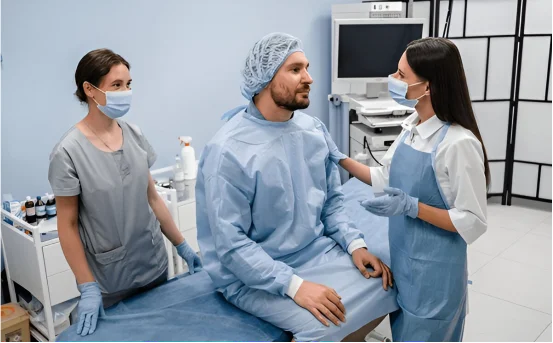Reconstructive urology surgery is a highly specialized field that focuses on restoring normal function and anatomy to the urinary and genital systems. This type of surgery is often necessary when there is damage or dysfunction caused by trauma, congenital abnormalities, infections, cancer, or previous surgeries.
These issues may arise due to congenital defects (birth anomalies), injuries, surgeries like prostatectomy, cancer treatments, infections, or even long-term catheter use. Reconstructive urology aims to not only improve the physical structure of the urinary tract but also enhance the patient’s ability to urinate normally, preserve kidney health, manage incontinence, and improve overall quality of life. This surgical field addresses both common and complex conditions ranging from urethral strictures and fistulas to severe trauma and neurogenic bladder. Some surgeries are minimally invasive, while others require intricate reconstructive techniques, especially when dealing with sensitive tissues like the urethra or bladder.
What is Reconstructive Urology?
Reconstructive urology is a subspecialty within urology that involves surgical procedures to repair, reroute, or rebuild parts of the urinary tract or genital organs. These surgeries are often complex and require expertise in both urology and plastic or microsurgery.
The goal of reconstructive urology is not just cosmetic—it is primarily functional. These surgeries aim to restore the patient’s ability to urinate normally, preserve kidney function, prevent infections, and improve quality of life.
Conditions Treated with Reconstructive Urology Surgery
Reconstructive urology surgery is recommended for a variety of conditions, including:
- Urethral Strictures :- A urethral stricture is a narrowing of the urethra, often due to injury, infection, or previous catheterization. It can lead to difficulty urinating, pain, or urinary tract infections (UTIs). Reconstructive surgery helps remove the scar tissue and widen the urethra.
- Bladder Fistulas :- Bladder fistulas are abnormal openings between the bladder and another organ, such as the vagina or bowel. These can result in urinary leakage and recurrent infections. Surgery closes the fistula and restores normal urinary function.
- Traumatic Injuries :- Accidents or pelvic fractures can damage the urethra, bladder, or genital organs. Reconstructive urology procedures can repair these injuries and restore normal anatomy and function.
- Hypospadias :- Hypospadias is a congenital condition in which the urethral opening is located on the underside of the penis. Pediatric urologists perform reconstructive surgery to reposition the urethral opening and correct the penile curvature.
- Neurogenic Bladder :- Patients with spinal cord injuries or neurological diseases may have trouble emptying their bladder. Reconstructive urology can help create alternative pathways for urine to exit the body, such as a catheterizable channel.
Urinary Incontinence Post-Prostate Surgery :- Men who experience incontinence after prostate surgery may benefit from urethral slings or artificial urinary sphincters, both of which fall under reconstructive urology.
Who Needs Reconstructive Urology Surgery?
Patients of all ages children, adults, and the elderly may need reconstructive urology surgery, depending on their condition. The need for surgery may arise from:
-
Birth defects (e.g., hypospadias, bladder exstrophy)
-
Trauma (e.g., pelvic fracture, straddle injury)
-
Post-surgical complications (e.g., prostatectomy incontinence, fistulas)
-
Radiation damage (e.g., from prostate or bladder cancer treatment)
-
Chronic infections or catheter-related damage
What to Expect Before and After Surgery
Before Surgery
-
Consultation :- Detailed discussion with your urologist about the procedure, risks, and outcomes.
-
Preoperative tests :- Blood work, urine tests, and imaging to assess your readiness.
-
Medication review :- You may be asked to stop certain medications temporarily.
-
Fasting :- Typically required the night before surgery.
After Surgery
-
Hospital stay :- Duration depends on the procedure—ranging from day care to a few days.
-
Catheterization :- You may have a urinary catheter for days or weeks to allow healing.
-
Recovery time :- Most patients resume normal activity in 2–6 weeks, depending on the surgery.
-
Follow-up :- Regular check-ups, imaging, or flow tests to assess surgical success and healing.
Risks and Complications
As with any surgery, reconstructive urology procedures carry some risks:
-
Infection
-
Bleeding
-
Scarring or recurrence of strictures
-
Urinary leakage or incontinence
-
Erectile dysfunction (in some pelvic surgeries)
Choosing a highly experienced urologist significantly reduces these risks.
Advances in Reconstructive Urology
Recent advances have greatly improved the success rates and comfort of patients undergoing reconstructive urology:
-
Minimally invasive techniques like robotic or laparoscopic surgery reduce scarring and recovery time.
-
Tissue engineering and stem cell research are opening doors to grow urethral or bladder tissue in the lab.
-
3D printing is being explored for complex anatomical reconstructions.
These innovations are making reconstructive urology safer, more effective, and more accessible than ever before.
Choosing the Right Reconstructive Urologist
When considering reconstructive urology surgery, choosing a qualified and experienced urologist is crucial. Look for:
-
Fellowship training in reconstructive urology
-
High-volume surgical experience
-
Access to advanced diagnostic and surgical facilities
-
Positive patient testimonials and outcomes
-
Clear communication about risks, expectations, and recovery
In India, leading multispecialty hospitals and urology centers in cities like Delhi, Mumbai, Chennai, and Bangalore offer world-class reconstructive urology services at affordable costs.
Conclusion
Reconstructive urology surgery can be life-changing for individuals suffering from complex urinary or genital issues. Whether it’s restoring normal urination, fixing structural abnormalities, or improving continence, these procedures aim to enhance both function and quality of life.
The primary goals of these surgeries are to restore normal urinary function, correct anatomical abnormalities, protect kidney health, and improve continence allowing patients to regain control over their bodies. In many cases, it also helps reduce the dependence on catheters, prevent recurring infections, and eliminate chronic pain or embarrassment.























